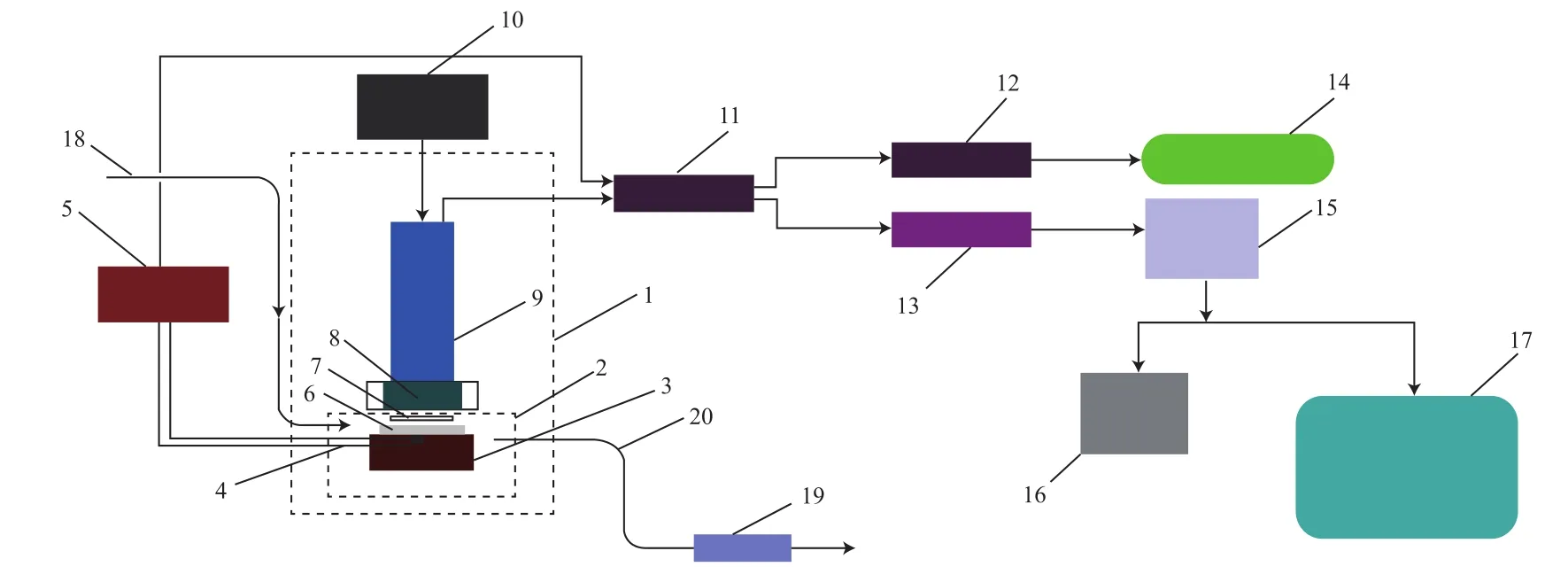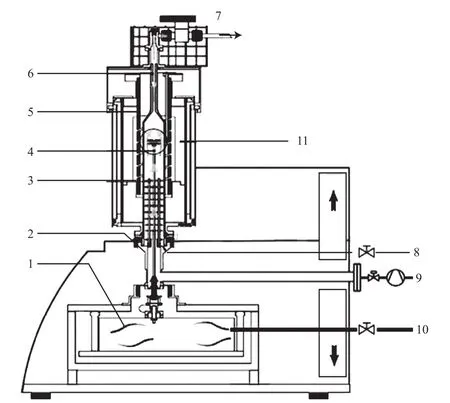聚烯烃氧化诱导时间的测试方法
苗小培,武 鹏,者东梅,杨化浩,郭若海
(中国石化 北京化工研究院,北京 100013)
聚烯烃树脂具有价格低廉、容易加工成型、综合性能优良等特点,是一类产量最大、应用最多的高分子材料。但是聚烯烃材料在加工、储存和日常使用过程中,会在光、热、氧和机械剪切等因素的作用下发生老化降解、变色和机械性能下降现象,从而影响制品的使用寿命[1-5],因此,需要在制品中添加适宜的抗氧剂以保证聚烯烃制品的使用寿命。抗氧剂的抗氧化能力一定程度上决定了聚烯烃的寿命,在聚烯烃新产品的开发和性能测试中正确评价抗氧剂的效果具有重要的意义,而氧化诱导时间(OIT)可用于评价聚烯烃的热氧化稳定性[6-10]。
OIT是指在氧气或空气气氛中,在规定的温度下恒温测定试样中的抗氧化稳定体系抑制试样氧化所需要的时间。OIT分析的基础是放热反应产生的热释放,常用的热分析技术有DSC和TG[11-13]。目前,国内外主要根据国际标准(ISO)、国家标准(GB)和美国材料与试验协会标准(ASTM)等,采用DSC法测定聚烯烃材料的OIT。Pospisil等[14]指出DSC测定OIT的实验通常需在聚合物熔点以上较高温度下进行,这导致了DSC数据不能和较低温度下固态聚合物的寿命相关联,而且低温下聚合物氧化速率太慢,用DSC法不仅耗时而且精准度较低。采用TG在低于180 ℃下测定OIT的灵敏度及准确度则较高[13]。1961 年 Ashby[15]首次报道聚烯烃在热氧化过程伴随有化学发光(CL),随后Schard等[16-17]也证实了该现象。CL作为研究聚烯烃氧化降解的一种极为敏感的方法已得到了普遍认可,该方法是通过标示固体或液体系统中被化学反应激活的分子释放出的光子工作的[18-20]。Hamskog等[21]指出CL在测定聚烯烃的OIT时较DSC具有更优秀的长期稳定性、准确度和灵敏度,因为CL信号不受其他吸热或放热反应的影响。尽管不同的方法各有优劣,但Camacho等[22]采用DSC,CL,TG技术对再生聚丙烯(PP)、高密度聚乙烯(HDPE)及二者共混物的热性能和耐热氧化稳定性进行了测试,结果表明此三种方法在测定熔点以上温度的OIT时所得结果一致。
本文介绍了DSC,CL和TG方法各自采用的仪器及工作原理,综述了这些方法在测试聚烯烃OIT的研究进展,并提出应该采用不同的测试方法综合判断材料的耐热稳定性。
1 DSC技术
1.1 DSC仪器的结构及测试原理
DSC是20世纪60年代以后出现的一种热分析方法,是在程序控制温度下,测量输入到试样和参比物的功率差与温度关系的一种技术。根据不同测量原理,DSC仪器主要分为功率补偿型和热流型两种(见图1)。从图1可看出,功率补偿型DSC是在试样和参比物始终保持相同温度的条件下,测定为满足此条件试样和参比物两端所需的能量差,并直接作为信号热量差(Δp)输出。热流型DSC是在给予试样和参比物相同的功率下,测定试样和参比物两端的温差(ΔT),然后根据热流方程,将ΔT换算成Δp作为信号输出[23]。DSC测定OIT是以分子键断裂时的放热反应为依据,测试聚烯烃在高温氧气中加速老化程度的方法:将试样与参比物置于DSC仪器中,在一定温度下用氧气迅速置换试样室的惰性气体(如氮气),测试由试样氧化引起DSC曲线变化,得到的OIT可用于评定试样的防热老化性能。

图1 功率补偿型(a)和热流型(b)DSC仪器的结构示意图[23]Fig.1 Schematic diagrams of power compensation(a) and heat flux(b) DSC[23].
1.2 DSC测试OIT的研究进展
利用DSC测定聚烯烃的OIT具有用量少、时间快、重复性好等优点,而且有通用的相关标准[24-26]。OIT作为典型的评价聚烯烃材料耐热稳定性能的指标,主要用于抗氧剂作用、含量、损耗及聚烯烃制品寿命的预测研究。
聚烯烃所用抗氧剂有不同的分类及作用[27-31]。Kriston等[32]研究了受阻酚类和亚磷酸酯类复配抗氧剂的消耗与聚合物性质的关系,借助DSC测定聚合物的OIT,并给出了OIT与残存抗氧剂含量的线性关系,得出链终止剂与过氧化氢分解剂复合使用才能达到作用上的互补,并具有良好的协同作用。Wang等[33]合成了高相对分子质量的含硫副抗氧剂,并与商业用低相对分子质量含硫副抗氧剂在PP中的抗氧化行为进行了对比,通过DSC测定OIT的结果表明,无论副抗氧剂单独使用还是与主抗氧剂复配使用,OIT均随副抗氧剂相对分子质量的增大而增大。Gao等[34]也通过测定低密度聚乙烯(LDPE)/抗氧剂(AO)-氨基硅烷偶联剂-SiO2膜和LDPE/AO膜的OIT证实了较高相对分子质量抗氧剂比较低相对分子质量抗氧剂的抗氧效率更好,同时通过监控两种膜的水萃取液的OIT变化得出抗氧剂已从LDPE中迁出。抗氧剂除了因挥发而消耗外,还会在光、热等作用下变质或与化学物质反应,在制品使用过程中发生迁移和被溶剂萃取出而产生不必要的损耗,从而降低了效率。Lundbäck等[35]报道了不同温度、厌氧和需氧条件下支链聚乙烯中Santonox R抗氧剂的物理迁移和化学反应,利用DSC测定两种介质体系的OIT结果显示,随老化时间的延长,OIT逐渐下降,抗氧剂从聚乙烯内部逐渐扩散并迁移至表面造成较大的物理损失,使聚乙烯的抗氧化效率明显下降,HPLC结果也证实了该现象。关于抗氧剂的物理迁移有许多文献报道[36-38],利用OIT数据计算发现抗氧剂的扩散系数与温度关系遵守Arrhenius定律,但该方法不足之处为:聚丙烯试样的OIT数据很难重复,特别是在其降解的初级阶段以及当诱导期很长的时候[39]。为此,Geertz等[38]利用红外显微镜首次监控到PP管中抗氧剂的迁移并考察了环应力和挤出速率对稳定剂迁移的影响,该方法比测试OIT更快速,重复性更好。
抗氧剂的损耗必然会缩短聚烯烃制品的使用寿命,热降解与使用寿命的关系运用最多的是Arrhenius方程。Bartoníček 等[40]通过测定聚烯烃的OIT并与断裂伸长率建立联系以推算电缆料的使用寿命。Gillen等[41]也通过长达7 a的乙丙橡胶(EPR)电缆加速老化实验(热炉和DSC),利用Arrhenius方程计算出EPR的活化能为88~128 kJ/mol,从而外推出电缆在50 ℃下的使用寿命超过300 a。Mueller等[42]比较了垃圾填埋场HDPE土工膜分别在80 ℃热炉空气老化13 a和浸水老化6 a后的机械性能和OIT。实验结果表明,热炉老化后HDPE的OIT呈较慢的指数降低,且机械性能并未减小,但浸水老化后的HDPE的OIT第1年就显著减小,第5年降至很低,同时拉伸强度下降至屈服点。根据van’t Hoff法则预测HDPE土工膜在室温的使用寿命约几个世纪之久。
现行标准中除了用DSC测定静态等温OIT,还可用动态氧化诱导温度(OIT*)评价聚烯烃材料的热氧化稳定性。Schmid[8,43]比较 OIT 和 OIT*评价聚合物抗氧化性的效果时发现,对于较易氧化且OIT较低的聚合物(特别是PP),OIT结果存在不确定度大、重现性差的问题。Pimentel等[44]给出了OIT和OIT*间的推导关系式,对于OIT为几个小时的聚烯烃试样,可采用快速OIT*作为质量控制和寿命预测的方法。
2 CL技术
2.1 CL仪器的结构及测试原理
CL主要是依据待测物浓度与体系的化学发光强度在一定条件下呈线性定量关系的原理,对体系化学发光强度进行检测,确定待测物含量的一种痕量分析方法,CL仪器的结构示意图见图2[45-46]。一般而言,采用CL技术须具备两个条件:1)化学反应能提供足够的能量,且能被反应过程中的某种光辐射体或光辐射中间体吸收;2)参与化学发光反应的物质常含有易被氧化或还原的基团,反应物、产物或中间体含有n或π电子,同时存在π*轨道。聚烯烃氧化过程产生的化学发光量子产率低至10-9,但化学发光仪因采用光电倍增管能检测低强度的发光,所以可以检测各种温度乃至室温下的氧化过程。

图2 CL仪器的结构示意图[45]Fig.2 Schematic diagrams of chemiluminescence(CL) instrument[45].
聚烯烃氧化产生的CL是由激发态羰基基团跃迁至稳态失活所形成的,Russell机理是被广泛接受的发光机理[47](见图3)。化学发光强度与过氧化物自由基相关使得CL成为聚烯烃热氧化一个较为理想的实时检测手段,此时OIT定义为从切换氧气开始到化学发光信号突然增强的时间[45,48]。

图3 CL 的 Russell机理[47]Fig.3 The Russell mechanism for CL emission[47].
2.2 CL测试OIT的研究进展
利用CL研究聚合物的氧化降解偏重于机理研究[47,49-50],在OIT方面的应用主要包括研究稳定剂的抗氧化效率、热氧化动力学及成像化学发光技术。
Zaharescu等[51]采用CL研究了添加辣椒素稳定剂的LDPE的抗热氧化性,OIT的增加说明辣椒素及金属硒具有协同抗氧化活性。Ambrogi等[52]通过CL和DSC技术测试生物基材料稳定的PP在170 ℃的OIT,结果显示,CL信号随时间的延长表示抗氧效率提高,另外观察到CL所测OIT稍短于DSC所测OIT,说明CL实验一开始就暴露在氧气环境中。Celina等[53]分析 PP粉末在 110~150 ℃下热氧化的CL数据发现,聚合物含有少量的高速氧化位点,在OIT这段时间中稳定剂的作用是阻止热氧化扩展至未氧化区域,OIT的氧化程度并不是固定不变的,而是随氧化温度的降低而增加,这说明PP的热氧化动力学为多相氧化反应。Verdu等[54]通过CL发光强度及氢过氧化物浓度关系推导出PP在80~150 ℃的热氧化动力学模型,热氧化反应的唯一自由基来源于POOH的单分子分解,OIT与POOH分解速率常数的倒数密切相关,而稳态速率与POOH分解速率常数无关,表观活化能随暴露时间的变化而变化。Gorghiu等[55]利用CL曲线计算200 ℃的OIT、半氧化期及最大氧化时间和速率以评价Al,Zn,Ti,Mo,Mn,Fe,Cu对LDPE、线型低密度聚乙烯、HDPE、超高相对分子质量聚乙烯热降解的影响。Hamskog等[56]借助成像化学发光技术观察PP饰板老化不同时间后的多相氧化降解现象发现:未老化饰板表现出随机分布的OIT,热空气老化饰板显示出与位点相关的降解,饰板边缘区域的OIT为零,靠近饰板中心的OIT增加。Ahlblad等[57]采用成像CL技术研究了PP废膜的热氧稳定性,并与未添加稳定剂的PP粒料对比,实验结果表明,不稳定PP粒料为均相氧化,OIT极低,而添加稳定剂的PP废膜具有较长OIT并受丝状缺陷的影响,所有的PP膜在OIT后其CL强度都呈S型增加,链增长氧化与CL强度增加相匹配。
Fearon等[58]通过测试物理机械性能(冲击强度、熔体流动指数、流动指数、泛黄指数等),同时利用CL及DSC技术对多次挤出PP的耐热氧化稳定性能进行了同步监测研究。实验结果表明,物理机械性能测试无法可靠地分辨不同配方稳定性的差别,但可发现稳定性较好的配方与稳定性较差的配方之间存在的较大差别;使用CL检测得到的OIT(CL-OIT)与使用DSC测定得到的OIT是一致的,但前者的可靠性高于后者。通过测试还发现CL-OIT数据分别与熔体流动指数和泛黄指数存在相关性。尽管CL技术具有更高的可靠性及灵敏度[21],但目前在工业研究领域中还未成为一种标准的OIT测试方法,主要是因为CL极低的量子产率需要高灵敏度的检测器,这种高精密仪器在材料应用研究方面是不适宜的[48]。
3 TG法
3.1 TG仪器的结构及测试原理
TG是在程序控制温度下,测量物质质量与温度关系的一种技术。该方法定量性强,能准确测量物质的质量变化及变化速率,是使用最多最广泛的一种热分析方法。TG分析仪主要由天平、炉子、程序控温系统、记录系统等几个部分构成(见图4)[59-61]。

图4 TG分析仪的结构示意图[59-61]Fig.4 Schematic diagrams of thermogravimetry instrument[59-61].
TG测试聚合物材料的OIT原理为:在恒定的温度下,从通氧气开始,直到TG曲线上发生增重的时间即为 OIT[62]。
3.2 TG测试OIT的研究进展
国内外通过TG研究聚烯烃的热稳定性主要在于研究降解温度、质量变化及动力学行为,对OIT这个耐热氧稳定性参数的报道则寥寥可数。Smoliak等[63]借助TG和吸氧法研究了多硫化物(PDS)稳定剂在聚乙烯中的抗热氧活性,从TG热降解动力学曲线上得到OIT,其中,OIT越长表示稳定效率越高,并给出OIT和PDS浓度的关系曲线。Kyriakou等[13]报道了利用TG技术测定OIT以评价LDPE的循环再利用技术。温室用LDPE膜使用后加入Recyclostab 421抗氧剂进行4次单螺杆挤出,监控每次挤出后的OIT,并与未加抗氧剂的LDPE膜的OIT进行比较,发现再稳定的LDPE试样的OIT在每个挤出循环均高于未稳定的LDPE,OIT与抗氧剂含量呈线性关系。刘志健等[64]采用TG技术测定PP的OIT,研究了测试温度、试样质量对OIT的影响。实验结果表明,PP的OIT随测试温度和试样质量的增加而降低,所得结果具有良好的重现性。
4 其他方法计算OIT
Achimsky等[65]都通过聚烯烃降解动力学计算OIT,指出PP的OIT仅取决于过氧化氢分解速率常数,并通过OIT计算出PP吸氧后增重、羰基增重与羟基增重的比例为2∶3∶3。Colin等[66]通过聚乙烯吸氧动力学曲线计算OIT、最大速率常数和活化能等参数,得出聚乙烯的热氧化为双分子分解机理。
5 结语
DSC、CL和TG方法测定聚烯烃的OIT各有优势及不足,尽管这三种检测方法的机理有所不同,但对于研究聚烯烃的耐热稳定性是可以互为补充的。可以选择DSC测定高温OIT,选择CL和TG测定低温OIT。因此,对于聚烯烃材料不能简单地用某一温度下的OIT判断材料的热氧稳定性,最好在不同的温度区间多测试几个温度点下的OIT来综合判断,并且同一温度下,尽量多测几个点,计算平均值,以消除取样误差。
[1] Badia J D,Gil-Castel O,Ribes-Greus A. Long-term properties and end-of-life of polymers from renewable resources[J].Polym Degrad Stab,2017,137:35-57.
[2] Santos A S F,Agnelli J A M,Trevisan D W,et al. Degradation and stabilization of polyolefins from municipal plastic waste during multiple extrusions under different reprocessing conditions[J].Polym Degrad Stab,2002,77(3):441-447.
[3] Kamila B,Ulrike B. Different aspects of the accelerated oxidation of polypropylene at increased pressure in an autoclave with regard to temperature,pretreatment and exposure media[J].Polym Test,2014,37:102-111.
[4] Gijsman P,Meijers G,Vitarelli G. Comparison of the UV-degradation chemistry of polypropylene,polyethylene,polyamide 6 and polybutylene terephthalate[J].Polym Degrad Stab,1999,65(3):433-441.
[5] Giurginca M,Popa L,Zaharescuc T. Thermo-oxidative degradation and radio-processing of ethylene vinyl acetate elastomers[J].Polym Degrad Stab,2003,82(3):463-466.
[6] Woo L,Khare A,Blom H P,et al. Application of the oxidative induction test to depolymerizing systems[J].Thermochim Acta,2001,367/368:113-118.
[7] Turi A. Thermal characterization of polymeric materials[M].2nd.San Diego:Academic Press,1997:2420.
[8] Schmid M,Affolter S. Interlaboratory tests on polymers by differential scanning calorimetry(DSC):Determination and comparison of oxidation induction time(OIT) and oxidation induction temperature(OIT*)[J].Polym Test,2003,22(4):419-428.
[9] Bartoníček B,Hnát V,Plaček V. Life-assessment technique for nuclear power plant cables[J].Radiat Phys Chem,1998,52(1/6):639-642.
[10] Lugao A B,Cardoso E C L,Hutzler B,et al. Temperature dependent oxidative-induction time(TOIT) of irradiated and non-irradiated polypropylene—A new method[J].Radiat Phys Chem,2002,63(3/6):489-492.
[11] Fitaroni L B,de Lima J A,Cruz S A,et al. Thermal stability of polypropylene-montmorillonite clay nanocomposites:Limitation of the thermogravimetric analysis[J].Polym Degrad Stab,2015,111:102-108.
[12] Cruz S A,Zanin M. Evaluation and identification of degradative processes in post-consumer recycled high-density polyethylene[J].Polym Degrad Stab,2003,80(1):31-37.
[13] Kyriakou S A,Statherpoulos M,Parissakis G K,et al. Oxidative induction time method based on thermogravimetry for monitoring the restabilization of post-use LDPE[J].Polym Degrad Stab,1999,66(1):49-53.
[14] Pospisil J,Horak Z,Pilar J,et al. Inf l uence of testing conditions on the performance and durability of polymer stabilizers in thermal oxidation[J].Polym Degrad Stab,2003,82(2):145-162.
[15] Ashby G E. Oxyluminescence from polypropylene[J].Polym Chem,1961,50(153):99-106.
[16] Schard M P,Russell C A. Oxyluminescence of polymers. Ⅰ.General behavior of polymers[J].J Appl Polym Sci,1964,8(2):985-995.
[17] Mendenhall G D. Analytical Applications of Chemiluminescence[J].Angew Chem Int Ed,1977,16(4):225-232.
[18] Billingham N C,Then E T H,Gijsman P J. Chemiluminescence from peroxides in polypropylene. Part Ⅰ:Relation of luminescence to peroxide content[J].Polym Degrad Stab,1991,34(1/3):263-277.
[19] Billingham N C,Then E T H,Kron A. Chemiluminescence from peroxides in polypropylene:Ⅱ. Luminescence and kinetics of peroxide decomposition[J].Polym Degrad Stab,1997,55(3):339-346.
[20] KronA,Stenberg B,Reitberger T. Chemiluminescence from oxidation of polypropylene:Correlation with peroxide concentration[J].Polym Degrad Stab,1996,53(1):119-127.
[21] Hamskog M,Klügel M,Forsström D. The effect of base stabilization on the recyclability of polypropylene as studied by multi-cell imaging chemiluminescence and microcalorimetry[J].Polym Degrad Stab,2004,86(3):557-566.
[22] Camacho W,Karlsson S. Assessment of thermal and thermooxidative stability of multi-extruded recycled PP,HDPE and a blend thereof[J].Polym Degrad Stab,2002,78(2):385-391.
[23] Hatakeyama T,Quinn FX. Thermal Analysis:Fundamentals and Application to Polymer Science[M].New York:Wiley,1994:158.
[24] International Organization for Standardization. ISO 11357-6—2008 Plastics Differential scanning calorimetry(DSC) Part 6:Determination of oxidation induction time (isothermal OIT)and oxidation induction temperature (dynamic OIT)[S].Geneva:ISO,2008.
[25] American National Standards Institute. ASTM D3895—2014.Standard test method for oxidative. Induction time of polyolefins by differential scanning calorimetry[S].West Conshohocken:ASTM International,2014.
[26] 中华人民共和国国家质量监督检验检疫总局. GB/T 19466.6—2009 塑料 差示扫描量热法(DSC) 第6部分:氧化诱导时间(等温OIT)和氧化诱导温度(动态OIT)的测定[S].北京:中国标准出版社,2010.
[27] Pospíšil J. Chemical and photochemical behaviour of phenolic antioxidants in polymer stabilization—A state of the art report.Part Ⅰ[J].Polym Degrad Stab,1993,40(2):217-232.
[28] Pospíšil J. Chemical and photochemical behaviour of phenolic antioxidants in polymer stabilization a state of the art report.Part Ⅱ[J].Polym Degrad Stab,1993,39(1):103-115.
[29] Zweifel H. Stabilization beyond the year 2000[J].Macromol Symp,1997,115(1):181-201.
[30] Ahmad S,Pawelke B,Zul figar S,et al. New stabilizers for polymers on the basis of IPDI protected 2,2-thiobis(4-methyl-6-tert-butylphenol) and hindered amines[J].Polym Degrad Stab,2001,72(1):47-51.
[31] Hassanpour S,Khoylou F. Synergistic effect of combination of Irganox 1010 and zinc stearate on thermal stabilization of electron beam irradiated HDPE/EVA both in hot water and oven[J].Radiat Phys and Chem,2007,76(11/12):1671-1675.
[32] Kriston I,Orbán-Mester A,Nagy G,et al. Melt stabilisation of Phillips type polyethylene,Part Ⅱ:Correlation between additive consumption and polymer properties[J].Polym Degrad Stab,2009,94(9):1448-1456.
[33] Wang Xiaofeng,Xing Weiyi,Tang Gang,et al. Synthesis of a novel sulfur-bearing secondary antioxidant with a high molecular weight and its comparative study on antioxidant behavior in polypropylene with two commercial sulfur-bearing secondary antioxidants having relatively low molecular weight[J].Polym Degrad Stab,2013,98(11):2391-2398.
[34] Gao Xiaowei,Hu Guangjun,Qian Zhongzhong,et al. Immobilization of antioxidant on nanosilica and the antioxidative behavior in low density polyethylene[J].Polymer,2007,48(25):7309-7315.
[35] Lundbäck M,Strandberg C,Albertsson A C,et al. Loss of stability by migration and chemical reaction of Santonox®R in branched polyethylene under anaerobic and aerobic conditions[J].Polym Degrad Stab,2006,91(5):1071-1078.
[36] Lundbäck M,Hedenqvist M S,Mattozzi A,et al. Migration of phenolic antioxidants from linear and branched polyethylene[J].Polym Degrad Stab,2006,91(7):1571-1580.
[37] Nawaz S,Hillborg H,Hedenqvist M S,et al. Migration of a phenolic antioxidant from aluminium oxide-poly(ethylene-cobutyl acrylate) nanocomposites in aqueous media[J].Polym Degrad Stab,2013,98(2):475-480.
[38] Geertz G,Brull R,Wieser J,et al. Stabiliser diffusion in long-term pressure tested polypropylene pipes analysed by IR microscopy[J].Polym Degrad Stab,2009,94(7):1092-1102.
[39] Volponi J E,Mei L H I,Rosa D D S. Use of oxidation onset temperature measurements for evaluating the oxidative degradation of isotatic polypropylene[J].J Polym Environ,2004,12(1):11-16.
[40] Bartoníček B,Hnát V,Plaček V. Life-assessment technique for nuclear power plant cables[J].Radiat Phys Chem,1998,52(1/6):639-642.
[41] Gillen K T,Bernstein R,Clough R L,et al. Lifetime predictions for semi-crystalline cable insulation materials:Ⅰ.Mechanical properties and oxygen consumption measurements on EPR materials[J].Polym Degrad Stab,2006,91(9):2146-2156.
[42] Mueller W,Jakob I. Oxidative resistance of high-density polyethylene geomembranes[J].Polym Degrad Stab,2003,79(1):161-172.
[43] Aroso I M,Fernandes E M,Pires R A,et al. Cork extractives exhibit thermo-oxidative protection properties in polypro-pylene-cork composites and as direct additives for polypropylene[J].Polym Degrad Stab,2015,116:45-52.
[44] Pimentel R L E,Correia M B. A comparative study on the thermo-oxidative stability of polyethylene[J].Polym Test,2012,31(7):963-969.
[45] Sorin I E,Radu S. Polymeric materials review on oxidation,stabilization and evaluation using CL and DSC methods[M].TE Technical Note,2009:23-38.
[46] Zlatkevich L. Chemiluminescence apparatus and method for studying thermal oxidative stability of polymers[J].Polym Eng Sci,1984,24(18):1421-1428.
[47] Kron A,Stenberg B,Reitberger T,et al. Chemiluminescence from oxidation of polypropylene:Correlation with peroxide concentration[J].Polym Degrad Stab,1996,53(1):119-127.
[48] Dudler V,Lacey D J,Kröhnke C. Chemiluminescence from polypropylene. Part 3:Application to the study of antioxidant effectiveness[J].Polym Degrad Stab,1996,51(2):115-124.
[49] Audouin L,Gueguen V,Tcharkhtchi A,et al. “Close loop”mechanistic schemes for hydrocarbon polymer oxidation[J].J Polym Sci,Part A:Polym Chem,1995,33(6):921-927.
[50] Jirackova L A,Verdu J. Chemiluminescence of hydrocarbon polymers[J].J Polym Sci,Part A:Polym Chem,1987,25(5):1205-1217.
[51] Zaharescu T,Jipa S,Henderson D,et al. Thermal and radiation resistance of stabilized LDPE[J].Radiat Phys Chem,2010,79(3):375-378.
[52] Ambrogi V,Cerruti P,Carfagna C,et al. Natural antioxidants for polypropylene stabilization[J].Polym Degrad Stab,2011,96(12):2152-2158.
[53] Celina M,George G A. Heterogeneous and homogeneous kinetic analyses of the thermal oxidation of polypropylene[J].Polym Degrad Stab,1995,50(1):89-99.
[54] Verdu S,Verdu J. A New kinetic model for polypropylene thermal oxidation at moderate temperatures[J].Macromolecules,1997,30(8):2262-2267.
[55] Gorghiu L M,Jipa S,Zaharescu T,et al. The effect of metals on thermal degradation of polyethylenes[J].Polym Degrad Stab,2004,84(1):7-11.
[56] Hamskog M,Terselius B,Gijsman P. Multi-cell imaging chemiluminescence to map heterogenerous degradation of polypropylene plaques[J].Polym Degrad Stab,2003,82(2):181-186.
[57] Ahlblad G,Gijsman P,Terselius B,et al. Thermo-oxidative stability of PP waste films studied by imaging chemiluminescence[J].Polym Degrad Stab,2001,73(1):15-22.
[58] Fearon P K,Marshall N,Billingham N C,et al. Evaluation of the oxidative stability of multiextruded polypropylene as assessed by physicomechanical testing and simultaneous differential scanning calorimetry-Chemiluminescence[J].J Appl Polym Sci,2001,79(4):733-741.
[59] Lai Zhiyi,Ma Xiaoqian,Tang Yuting,et al. Thermogravimetric analysis of the thermal decomposition of MSW in N2,CO2and CO2/N2atmospheres[J].Fuel Process Technol,2012,102:18-23.
[60] Earnest C M. Modern thermogravimetry[J].Anal Chem,1984,56(13):1471A-1486A.
[61] Shiono A,Hosaka A,Watanabe C,et al. Thermoanalytical characterization of polymers:A comparative study between thermogravimetry and evolved gas analysis using a temperature-programmable pyrolyzer[J].Polym Test,2015,42:54-61.
[62] Turk M J,Ansari A S,Alston W B,et al. Evaluation of the thermal oxidative stability of polyimides via TGA techniques[J].J Polym Sci,Part A:Polym Chem,1999,37(21):3943-3956.
[63] Smoliak L Y,Prokopchuk N R,Losev Y P. Thermal stabilizing activity of polydisulfides in polyethylene studied by oxygen uptake and thermogravimetric analysis[J].Polym Degrad Stab,2005,88(3):468-472.
[64] 刘志健,余巧玲,王万卷. 基于热重分析法测定聚丙烯塑料的氧化诱导时间[J].橡塑技术与装备,2015,41(22):111-114.
[65] Achimsky L,Audouin L,Verdu J. Kinetic study of the thermal oxidation of polypropylene[J].Polym Degrad Stab,1997,57(3):231-240.
[66] Colin X,Fayolle B,Audouin L,et al. About a quasi-universal character of unstabilised polyethylene thermal oxidation kinetics[J]. Polym Degrad Stab,2003,80(1):67-74.

